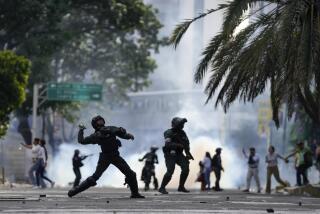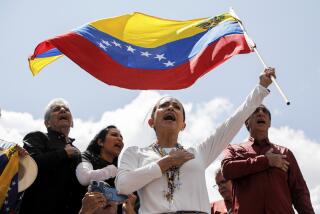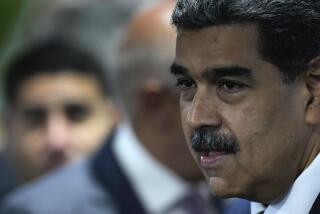Bush Ends Trip With Praise for Reduced State Role in South American Economies : Diplomacy: He salutes a move to expand trade and hails a new spirit of respect between north and south.
CARACAS, Venezuela — President Bush completed a weeklong tour of South America on Saturday, lauding it as a “profile in courage” whose leaders and people have “thrown off the shackles” of state-run economies in exchange for reborn private enterprise.
Bush set out on the journey with modest goals: After a two-year period in which enormous transformations had taken place in Eastern Europe, he wanted to salute the important, but less publicly dramatic, shifts that have occurred in some of the nations of South America that are potential future economic powers.
From his first stop in Brazil on Monday to his last here in Venezuela on Saturday, with intermediate stops in Uruguay, Argentina and Chile, he was able to do that, while marking the shift in U.S.-South American relations that has erased, at least on the surface, decades of tension.
Less than a year after Washington’s invasion of Panama--which led to the overthrow and capture of dictator Manuel A. Noriega and cast a shadow over Latin American views of its gigantic northern neighbor--Bush faced few signs of overt hostility on the streets of some of the continent’s major cities. And he received warm welcomes from the host countries’ leaders, even though tangible results of the visit are slim if measured by agreements signed.
Bush saluted, as previous Presidents have done, “a new understanding” between north and south and “a spirit of mutual respect.” And new leaders of some of South America’s largest nations, as well as the president of Uruguay, a small country with one of the region’s largest middle classes in proportion to its population, see eye to eye with Bush on the importance of democracy in the region, as well as on the role of the private sector after years of heavy state involvement in running major industries.
Speaking to the Venezuelan-American Chamber of Commerce, Bush said Saturday before returning to Washington that, two decades ago, Latin America hewed to the idea that “the state had to shelter local industries and protect them behind high tariff walls . . . and that an increasingly intrusive state rather than a liberated people was the formula for economic growth.”
Now, he said, new leaders are “stripping away state controls, selling off inefficient state-owned enterprises, realigning overvalued exchange rates and bringing down tariff walls.”
“The road to growth, jobs and rising income is through new investment, expanded trade and unleashing the energy of entrepreneurs,” Bush said.
Throughout the trip, Bush stressed his interest in creating a free-trade zone from Alaska to Argentina. That message is now falling on friendly ears, as leaders seek signs that the President of the United States is paying attention to them--and as they see increased production, the result of expanded markets, as better for their economies than protecting local industries from competition as a way of preserving jobs.
The United States has more than just a neighborly interest in seeking market expansion and a renewal of its focus toward the south, a senior Administration official said. He noted that South America is 10 times as large as Eastern Europe and twice as populous.
“In 1988,” he said, “we exported about $1.4 billion in products to Eastern Europe. We exported $23 billion to South America.”
And, he said, each of the leaders with whom Bush met “recognize that in a global economy you need to trade and compete in order to grow and prosper.”
Still, the problems are daunting throughout Latin America.
A study by the Aspen Institute, a U.S. public policy research organization, cited the enormous debt burdens: The aggregate debt is $410 billion. That means $25 billion more is being paid out annually in interest and principal than is obtained in new loans. As a result, the Latin American countries are being deprived “of the resources needed for investment and crucial imports,” and budget deficits remain high, inflation skyrockets and investor confidence fades.
In oil-rich Venezuela, where Bush spent 24 hours, the President
encountered an economic model and a political history somewhat different from those of the other countries he visited. This country has a longer tradition of democratic rule, and its per-capita income of $2,058 is among the highest in Latin America.
And in meeting with President Carlos Andres Perez, Bush was dealing with an experienced Latin leader who over the course of two decades has undergone a shift in his economic approach.
Perez, as president from 1974 to 1979, presided during a period of excessive government spending that drove the country into deep economic troubles, fueled by its foreign debt. But a new-model Perez, beginning a second term in 1989, has followed much more stringent economic policies, cutting the budget, lifting most price controls, reducing tariffs and moving toward privatization of many state enterprises--moves that shrank the economy by 8% last year.
Unlike the other nations Bush visited, Venezuela’s economic problems have to some degree been alleviated, rather than made worse, by the crisis in the Persian Gulf.
Oil has contributed mightily to making Venezuela one of the richest countries in Latin America, and Caracas is a teeming metropolitan area of more than 3.7 million.
Its 20- and 30-story office and apartment complexes preside over horn-honking traffic jams of large American automobiles. That was the Caracas that Bush could see from his motorcades. But on the edges of the city--clinging to the cloud-topped hillsides over which his helicopter carried him to and from the international airport on the Caribbean coast--live tens of thousands of families in “ranchos,” ramshackle huts made of corrugated metal and other salvaged materials.
Of Venezuela’s $12.9 billion worth of exports in 1989, $10 billion came from oil. That oil income should grow in 1990 and 1991. The run-up in oil prices as a result of the crisis in the Persian Gulf has become a mini-bonanza for Venezuela, which has some of the world’s most important oil reserves.
The Aspen Institute study, made public last week, said the sudden petroleum price increase has meant a $10-billion windfall for regional oil producers, with most of it going to Venezuela, Mexico, Ecuador and Colombia.
BACKGROUND
The discovery of oil in 1914 near Maracaibo, on the Caribbean coast, has made Venezuela one of South America’s richest nations. It has reserves to last 100 years at current production rates. A founding member of the Organization of Petroleum Exporting Countries, Venezuela rode a wave of prosperity in the 1970s. When the wave broke in the 1980s, the nation was awash in debt. Hard times led to a move to diversify the Venezuelan economy, with the aim of reducing dependency on the volatile oil market. The Persian Gulf crisis, which cut off oil exports from Iraq and Kuwait, has been a boon to Venezuela: Increased production and a surge in prices have generated an estimated $600 million a month in additional oil revenues.
More to Read
Sign up for Essential California
The most important California stories and recommendations in your inbox every morning.
You may occasionally receive promotional content from the Los Angeles Times.










